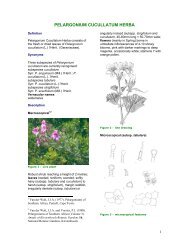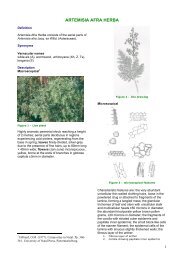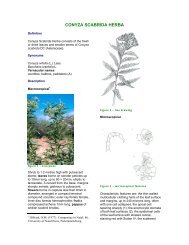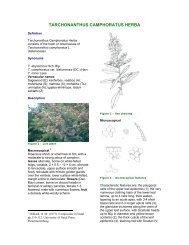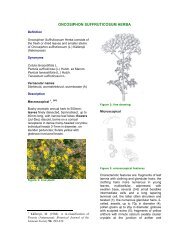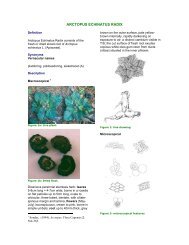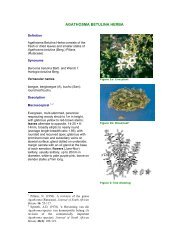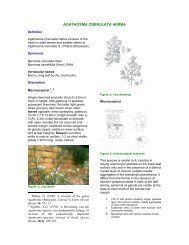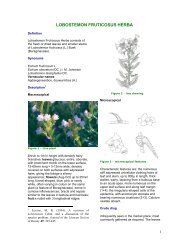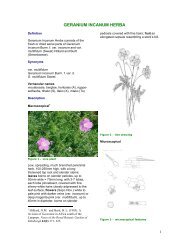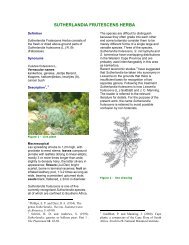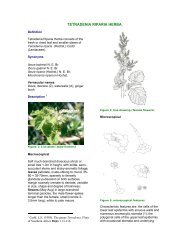NYLANDTIA SPINOSA HERBA - PlantZAfrica
NYLANDTIA SPINOSA HERBA - PlantZAfrica
NYLANDTIA SPINOSA HERBA - PlantZAfrica
You also want an ePaper? Increase the reach of your titles
YUMPU automatically turns print PDFs into web optimized ePapers that Google loves.
Definition<br />
Nylandtia Spinosa Herba consists of the<br />
flowering tops of Nylandtia spinosa (L.)<br />
Dumort. and of N. scoparia (Eckl. and<br />
Zeyher) Goldblatt and J.C.Manning.<br />
Synonyms<br />
Mundia spinosa (L.) DC<br />
Vernacular names<br />
Skilpadbessie, bokbessie, duinebessie (A),<br />
mmaba (Ts)<br />
Description<br />
Macroscopical<br />
Figure 1a – Live plant flowers<br />
Figure 1b – Live plant fruits<br />
Nylandtia scoparia has recently been<br />
recognised as a new species and<br />
distinguishable from N. spinosa, of which it<br />
was formerly considered an ecological race,<br />
<strong>NYLANDTIA</strong> <strong>SPINOSA</strong> <strong>HERBA</strong><br />
by its taller habit, weak spinescence and<br />
later flowering season GR3 .<br />
Erect or rounded, stiff, spinescent, sparsely<br />
leafed deciduous shrub reaching 2.5m in<br />
height; leaves borne on short stalks on<br />
spine-tipped branches, oblong, subsessile,<br />
3-7 × 2-3mm; flowers (June-Aug) solitary,<br />
axillary, purple, lilac, pink, occasionally<br />
white, small (±5mm long), pea-like, with<br />
fringed crest on lower petal; fruit (Oct-Dec)<br />
an edible glossy red berry.<br />
Microscopical<br />
Figure 2 – line drawing<br />
Figure 3- microscopical features
Characteristic features are: the polygonal<br />
cells of the leaf epidermis with thick striated<br />
cuticle and actinocytic stomata (1 - 4); the<br />
unicellular curved clothing hairs of the leaf<br />
lamina, up to 100µ long, with warty walls<br />
and acute apex (5); the absence of calcium<br />
oxalate crystals.<br />
Crude drug<br />
Collected when needed or available in the<br />
marketplace as bundles of fresh or dried<br />
young stems and leaves. Flowers and fruit<br />
may be present. Odour faint pleasant,<br />
texture stiff, thorny.<br />
Geographical distribution<br />
Figure 4 – distribution map<br />
Nylandtia scoparia is confined to the<br />
Western Cape Province, from the Bokkeveld<br />
Mountains to Darling, while N. spinosa is<br />
more widespread, occurring in the Western<br />
and Eastern Cape Provinces and<br />
Namaqualand. Both grow on sandy flats and<br />
slopes, sometimes side by side.<br />
Quality standards<br />
Identity tests<br />
Thin layer chromatography on silica gel<br />
using as solvent a mixture of toluene:diethyl<br />
ether:1.75M acetic acid (1:1:1). Reference<br />
compound cineole (0,1% in chloroform).<br />
Method according to Appendix 2a.<br />
Figure 5 – TLC plate<br />
Rf values of major compounds: 0,36 (tawny<br />
brown); 0,52 (acid green); 0,74 (sage<br />
green); 0,81 (sage green); cineole: 0,77<br />
(blue-purple)<br />
Figure 6 – HPLC spectrum<br />
HPLC on C18 column, method according to<br />
Appendix 2b.<br />
Major compounds:<br />
Methanol extract<br />
Retention times (mins): 22.18; 23.01<br />
Ethanol (70%) soluble extractive value: not<br />
less than 32.58% (range: 32.58-39.95%)<br />
Purity tests<br />
Assay<br />
Not yet available<br />
Major chemical constituents
Figure 7 – chemical constituents<br />
There is nothing in the published literature<br />
concerning the secondary chemistry of this<br />
species. Phytochemical tests in our<br />
laboratories indicated the presence of<br />
saponins, tannins and reducing sugars but<br />
not of alkaloids nor of anthraquinone<br />
glycosides. Cardiac glycosides were<br />
recorded as present in 1/3 collections.<br />
Triterpenoid saponins e.g. senegin (Polygala<br />
senega) are characteristic of the family GR9 .<br />
Dosage forms<br />
A leaf decoction or infusion is taken orally.<br />
Medicinal uses<br />
This herb is currently used as a remedy for<br />
stomach ache, acidity and flatulence in<br />
children. It is regarded as having narcotic<br />
properties and being of value in the<br />
treatment of sleeplessness and nervous<br />
disorders. The root is used by the Tswana<br />
people as a malaria remedy and is reputed<br />
to promote sweating GR1 . It was formerly<br />
used as a treatment for phthisis GR19 .<br />
Pharmacology/bioactivity<br />
Little is known of the pharmacology of this<br />
species. Other species in the family, notably<br />
those belonging to the large genus Polygala,<br />
are used as expectorants, diaphoretics,<br />
sedatives and tonics in both traditional and<br />
allopathic systems of medicine.<br />
Contraindications<br />
None known<br />
Adverse reactions<br />
None recorded<br />
Precautions<br />
No special precautions<br />
Dosage<br />
To be determined<br />
Copyright in this monograph resides with the authors, the South<br />
African National Biodiversity Institute, the South African Medical<br />
Research Council and the University of the Western Cape. It may<br />
not be reproduced in whole or in part without the written consent of<br />
the copyright holders.



